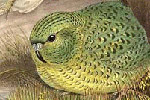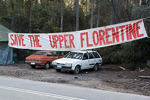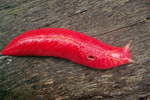Revelations of koalas suffering graphic injuries and death in Victorian timber plantations are evidence of a long-standing failure to properly protect the iconic Australian marsupials, according to a leading conservation organization.
Footage on Monday night’s 7.30 report showed koalas, including babies, lying dead on the floor of a cleared forest. One koala was missing an arm while another injured animal relocated to a new area of bush was shown to be in visible distress.
The report featured claims that large numbers of koalas are being wiped out in Victoria, in large part due to logging practices in the south-west of the state.
An anonymous timber worker said that finding dead koalas was “like a daily thing. Sometimes a couple every hour. Sometimes just one a day. You’d normally come across them on the ground already dead or pretty badly injured.”
Koalas have moved into the blue gum timber plantation fields due to the dwindling of the animals’ native forest habitat.
The marsupials are then killed or seriously crippled when trees are felled by timber contractors, with wildlife volunteers confronted by broken backs, severed limbs and dead mothers with joeys.
 Koala in Tasmania. Photo by: J.J. Harrison/Creative Commons 3.0. |
Deborah Tabart, the chief executive of the Australian Koala Foundation, told Guardian Australia that public revulsion over the deaths should be aimed at federal and state governments that have failed to safeguard koalas.
“I knew things were bad, but didn’t know they were quite that grim,” she said. “I’ve seen a lot of terrible things happen to koalas, but this is the best ammunition I’ve ever had to get koalas properly protected.
“No one is taking full responsibility for the koala. It’s a native icon but everyone is saying it’s someone else’s job. The government has allowed industry to completely self-regulate. We need a new koala protection act that says you simply can’t touch a tree where a koala lives.”
Tabart said the Victorian government had failed to check that loggers were reducing risks to koalas, while the federal government had erred by not listing the animal as endangered in Victoria.
Last year, then federal environment minister Tony Burke listed the koala as endangered, but only in NSW, Queensland and the ACT.
“I’m angry with Tony Burke for not listing it properly and I have no respect for the Victorian government, which has just asked industry what it’s doing and they’ve said ‘no worries, mate’. It seems that the Victorian government truly believes koalas are pests that require no management at all. There has been massive cruelty to koalas in Victoria over the years,” Tabart added.
Greens senator Lee Rhiannon said that the scale of koala deaths and injuries was “very disturbing”. “The logging industry urgently needs harvesting protocols to ensure trees are cut with minimum impact on koalas, and koala habitat is protected so healthy populations are easily able to move across the landscape,” she said.
“I call on government ministers to stop regarding koalas as pests and show leadership to provide the protection Australians expect koalas to be given.”
Andrew Pritchard, program manager of terrestrial biodiversity at Victoria’s Department of Environment and Primary Industries, said: “There are significant numbers of koalas in most suitable habitats across the south-west. The high population numbers have resulted in many moving into the blue gum estate in the region. This is a significant issue for the timber plantation industry that they haven’t had to address before.
“The increase in koala numbers reported in individual plantations has prompted Depi, wildlife carers and industry to come together to formulate new management procedures. Depi is working with the blue gum plantation industry in the south-west to make sure it responds humanely and effectively to the recent influx of koalas onto its plantation estate.”
Original Post: Conservationists accuse governments of failing to protect koalas
Related articles
Naturalist rediscovers the long-lost night parrot

(07/16/2013) An Australian bushman and naturalist claims to have captured video footage of the night parrot, a bird not seen alive for more than a century. John Young, who describes himself as a wildlife detective, showed the footage and a number of still photos of the bird to a packed room of enthusiasts and media at the Queensland Museum on Wednesday. The desert-dwelling night parrot, Pezoporus occidentalis, has never been photographed and the only evidence of its continued existence has been two dead birds found in 1990 and 2006.
Decades-long fight leads to old-growth forest protection in Tasmania

(06/25/2013) Almost 200,000 hectares of Tasmania’s old growth forest have been world heritage listed, bringing hope that a three-decade fight between environmentalists, politicians and loggers is over. The World Heritage Committee has extended the heritage listed boundary of the Tasmanian Wilderness World Heritage Area by more than 170,000 hectares after accepting a proposal from the Australian government which will give the areas the highest level of environmental protection in the world.
Giant hot pink slug in Australia becomes conservation symbol (photo)

(06/09/2013) Hot pink slugs that emerge after rainy nights have become a conservation symbol for alpine forests on Australia’s Mount Kaputar. The slugs, which measure up to 20 centimeters (8 inches), are only found on Mount Kaputar, a volcano that last erupted 17 million years ago. They spend most of their time buried under leaf litter, but emerge by the hundreds when conditions are right to feed on moss, algae, and fungi.
Scientist: Australia taking ‘calculated actions’ to push Leadbeater’s possum to extinction

(06/06/2013) Australia’s leading scientific expert on the endangered Leadbeater’s possum has publicly lambasted the Victorian state government, claiming it is the first ever domestic administration to take “calculated actions” that it knew could wipe out a threatened species. In a letter published in the respected journal Science, Prof David Lindenmayer, of the Australian National University, states that “government-sanctioned legal logging of the reserve system will significantly increase the chance of extinction of Leadbeater’s possum.”